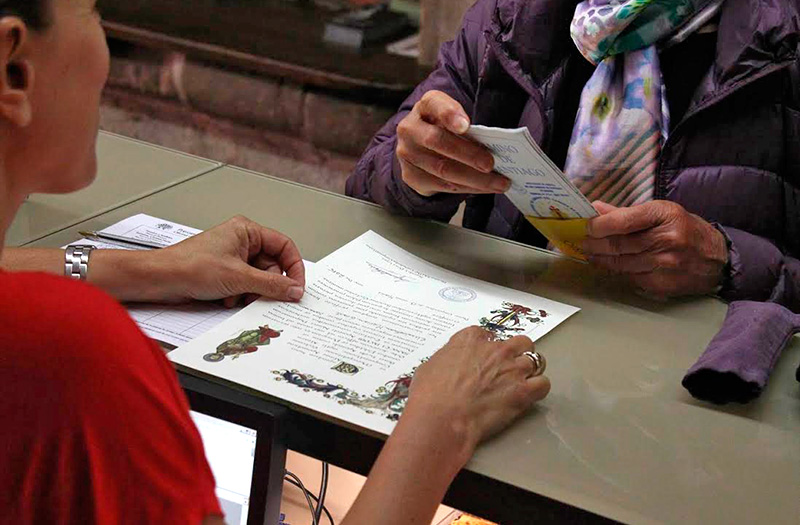The “Compostela“, the accreditation of the pilgrimage to the Tomb of St. James.
Since the pilgrimage to the tomb of Santiago, which came about spontaneously before the ninth and tenth centuries, was institutionalised and took on certain social and religious considerations, it was necessary to accredit its completion. To do this, badges were first used that could only be acquired in Santiago, in the shape of the scallop shell. It is obvious to see how easy it was to falsify this rudimentary certification. The counterfeiting soon took on and they were sold at the entrance to the city, forcing the prelates of Compostela and the Pope himself to decree excommunication penalties against the counterfeiters. More effective, as they were more difficult to counterfeit, were the so-called cartas probatorias (evidentiary letters), which were already issued in the 13th century. These letters led directly to the Compostela.
In the 16th century the Catholic Monarchs constituted the Foundation of the Royal Hospital and to house it they commissioned the building now occupied by the Hostal dos Reis Católicos, converted in 1954 into a luxury hotel. On presenting the Compostela, pilgrims acquired the right to stay free of charge for three days. The pilgrims’ health needs turned the institution, after the necessary extensions, into the most important hospital in Galicia and later into the headquarters of the famous Compostela medical school. In 1954 it became a Parador de Turismo hotel, although, as a tradition of hospitality, the hotel continues to offer free meals to the first pilgrims each day who come to the Hostal; they must always present the “Compostela” or a photocopy of it.
The appearance of motor vehicles and, in this century, the popularisation of tourism, represented somewhat of a crisis for pilgrimage: it was feared that the effort and sacrifice in the expiation of sins embraced in the pilgrimage on foot would be exchanged by a pleasant and enjoyable activity for the holidays. Such was the case that authorities in other sanctuaries began to issue visiting certificates imitating the “Compostela”. The Chapter of the Metropolitan Church of Santiago continued to issue the certificate and in modern times the award of the “Compostela” is limited to those who come to the tomb of the Apostle for religious and/or spiritual reasons, and following the routes of the Way of St. James on foot, by bicycle or on horseback. They are required to have travelled at least the last 100 kilometres on foot or horseback or the last 200 by bicycle, which is demonstrated by the “Credencial del Peregrino” duly stamped along the route travelled. Therefore other forms of travel to access the Compostela are excluded, except in the case of the disabled.
To get the “Compostela” you must:
- Make the pilgrimage for religious or spiritual reasons, or at least an attitude of search.
- Do the last 100 km on foot or horseback, or the last 200 km by bicycle. It is understood that the pilgrimage starts at one point and from there you come to visit the Tomb of St. James.
- You must collect the stamps on the “Credencial del Peregrino” from the places you pass through to certify that you have been there. Stamps from churches, hostels, monasteries, cathedrals and all places related to the Way are preferred, but if not they can also be stamped in other institutions: town halls, cafés, etc. You have to stamp the Credencial twice a day at least on the last 100 km (for pilgrims on foot or on horseback) or on the last 200 km (for cyclists pilgrims).
You can do the Way in stages, provided they are in chronological and geographical order. However, if you only do the minimum required distance (last 100 or 200 km), you must always get your Credencial stamped at the start and end of each stage, including the corresponding date, to show that the pilgrim has resumed the Way in the same place where they last stopped (i.e. you should always get the stamp at the starting point even though you have already stamped the card in the same place at the end of the previous stage).
Children and pilgrimage. Children who make the pilgrimage with their parents or in groups, and have received the sacrament of Communion, or have the ability to understand the meaning of the spiritual or religious nature of the Way, can receive the “Compostela”. If they are not mature enough due to their young age, they are given a special certificate with their names. In the case of infants or very young children, their names are included on the parent or accompanying adult’s “Compostela”. If you are in any doubt, please contact us at the Pilgrim’s Reception Office so we can look at each individual case.
The English translation of the text is as follows:
The Chapter of this Holy Apostolic and Metropolitan Cathedral of Compostela, custodian of the seal of the Altar of St. James, to all the Faithful and pilgrims who arrive from anywhere on the Orb of the Earth with an attitude of devotion or because of a vow or promise make a pilgrimage to the Tomb of the Apostle, Our Patron Saint and Protector of Spain, recognises before all who observe this document that: …………… has devotedly visited this most sacred temple having done the last hundred kilometers on foot or on horseback or the last two hundred by bicycle with Christian sentiment (pietatis causa).
In witness whereof I present this document endorsed with the seal of this same Holy Church.
Issued in Santiago de Compostela on ……… of …………… year of our Lord ……….
The Dean of the Cathedral of Santiago.


